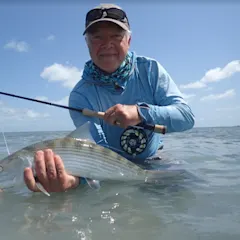HERE’S WHAT I’VE SEEN in my first three hours of jackrabbit hunting in the Sonoran Desert’s middle of nowhere: Stalking through the mesquite and paloverde, shimmying past the occasional stout ocotillo, I have seen jackrabbits hauling jackrabbit ass. I’ve seen them flying across the desert scrub like ground-hugging missiles. I’ve seen them pronking like antelope and plowing at 30 mph with their heads down to the ground like pointing dogs. When they’re on the move, it’s hard to miss an antelope jackrabbit. They are simply huge, among the largest lagomorphs in the world. A trophy antelope jackrabbit can push 13 pounds. The tops of their ears can be 3 feet from the ground. And despite their size, they are the second-fastest land animal in North America, having been clocked at 50 mph, lagging slightly behind the pronghorn antelope.
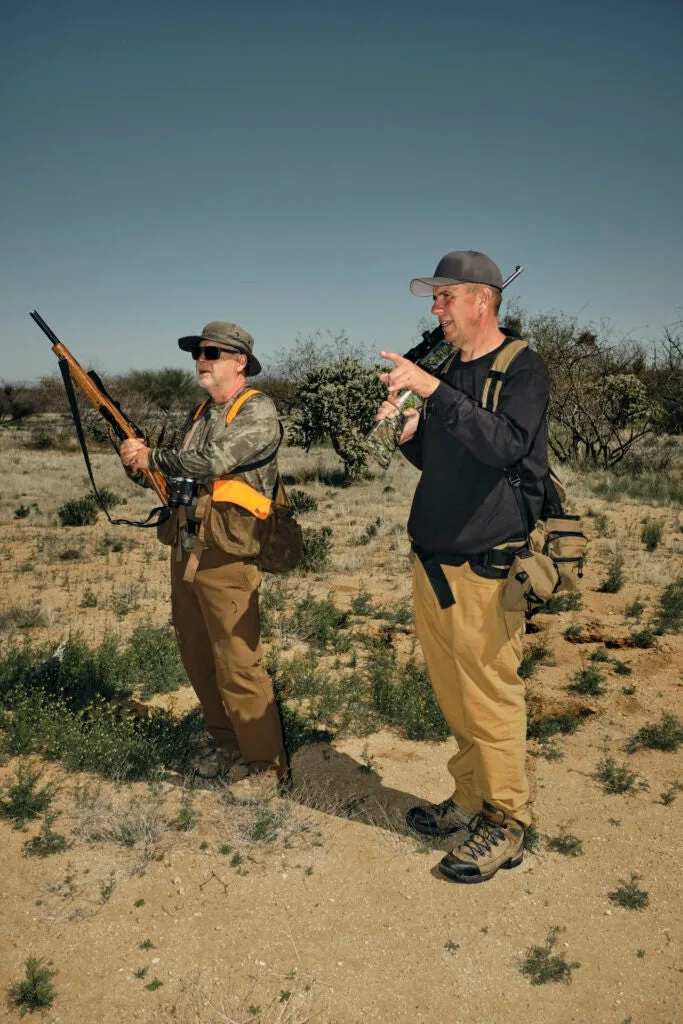
The author (left) and O’Dell strategize a hunting plan. Ian Allen
To be honest, I had a different image in mind. As we were driving southwest from Tucson, with camping gear for four days and enough rimfire rifle ammunition to open a country store, Johnathan O’Dell told me that antelope jacks often feed most of the night and into the dawn hours. Then they sit, fat and happy, and with their tushes tucked into brush, cocked like hammer guns and ready to vault if danger approaches. That’s what I’m looking for, but with most of the morning behind me, I have seen at least two dozen antelope jacks, and not a single one was backed into the shade and cooling its elongated heels. And in three hours of watching jackrabbits burn rubber every time I get within 75 yards, I’ve not yet had a single decent shot.
Until one big bunny makes a mistake.
I didn’t really see the jackrabbit as much as sense its movement—off in the right corner of my eye where little is in focus and what details appear should be double-checked and questioned. I glassed a snarl of paloverde and prickly pear and found half an ear and the hunched-over back of a jack in the knotty brush. I stalked the rabbit at an angle to keep it from getting nervous at a straight-on approach, searching for a shot. I found one that clipped a prickly pear pad but still made its mark. When I picked up the rabbit, its ears reached nearly to my chest with its hind feet touching the desert floor. I’m not a tall guy, but over the next four days, whether they run, hide, fold up with a shot, or simmer in a skillet, I will be astonished at the size of these animals. And amazed at how much fun it is to hunt them in such stark, challenging country.
A Road Trip to Jackrabbit Camp
For our hunt, we set up a tent camp on a sprawling mosaic of massive private ranches southwest of Tucson that are open to public hunting thanks to a state-run private-lands initiative. I pitch my one-man tent at least 10 middle-of-the-night paces from the nearest cholla cactus while O’Dell goes all out with a full-blown wall tent and a camp kitchen that could feed half of Coronado’s army. He digs a Dutch-oven-size hole for a jackrabbit barbacoa and strings a stout rope over a mesquite tree for a jackrabbit gambrel. Then we prep daypacks for the next morning’s dawn patrol. Spot-and-stalk antelope jackrabbit hunting is a high-energy pursuit, requiring stout hunting boots and plenty of drinking water, as we will beagle the bunnies ourselves, hiking for miles in the desert to push the rabbits out of hiding and into the range of copper-jacketed hollow-point rimfire rounds.
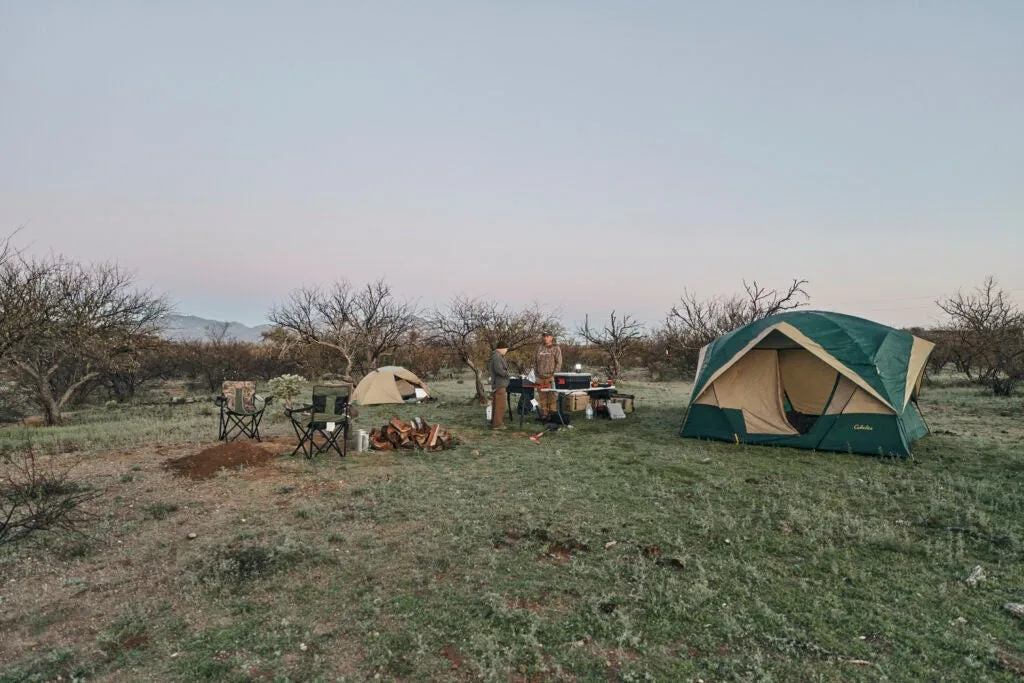
Morning at jackrabbit camp. Ian Allen
I met O’Dell two years ago at the Backcountry Hunters & Anglers wild-game cook-off, where he and a pal took top honors with a Navajo-Asian mashup recipe for antelope jackrabbit tacos. His day job is as small-game coordinator for the Arizona Game and Fish Department, but his grasp of the history of small-game hunting across the country is a wonder. He talks in a nearly unbroken stream of consciousness that can, without a break, ricochet from the asteroid that Neil deGrasse Tyson insists is headed for Earth to the day O’Dell spent at a renaissance fair with his daughter to the fact that tree squirrels are the only game animals with a collarbone to the proper way to float a chile relleno while frying it with an egg wash.
Otherwise it’s O’Dell’s Rabbit News Network, 24/7:
Most people have no clue how cool rabbits are. The Sumatran striped rabbit vanished 80 or 90 years ago, then someone had trail cams out a few years back and boom, they catch a pic of one. And the Annamite striped rabbit of the Vietnam–Laos border was just described maybe 10 years ago. A zebra-looking rabbit—who wouldn’t want to go hunt that?
Jackrabbits were originally called “jackass rabbits” because of their ears. Mark Twain either coined that term or picked it up from some other pioneer.
You know about the jackalope, right? But there’s a long tradition of mythological rabbits in Europe—the dilldapp, the rasselbock, and, my favorite, the wolpertinger, a rabbit with feathered wings, fangs, and roebuck antlers. A 14th-century French treatise actually mentions horned rabbits.
He’s momentarily thrown off his stride when I tell him that I have visited the jackalope sculpture at the South of the Border roadside attraction on the North Carolina–South Carolina state line, one of only two known works of such statuary outside the West.
“Really?” he asks. His face registers both shock and awe. “You’ve actually seen it?” But he recovers. On our second day in the scrub, I am carefully picking my way through the brush when O’Dell calls over.
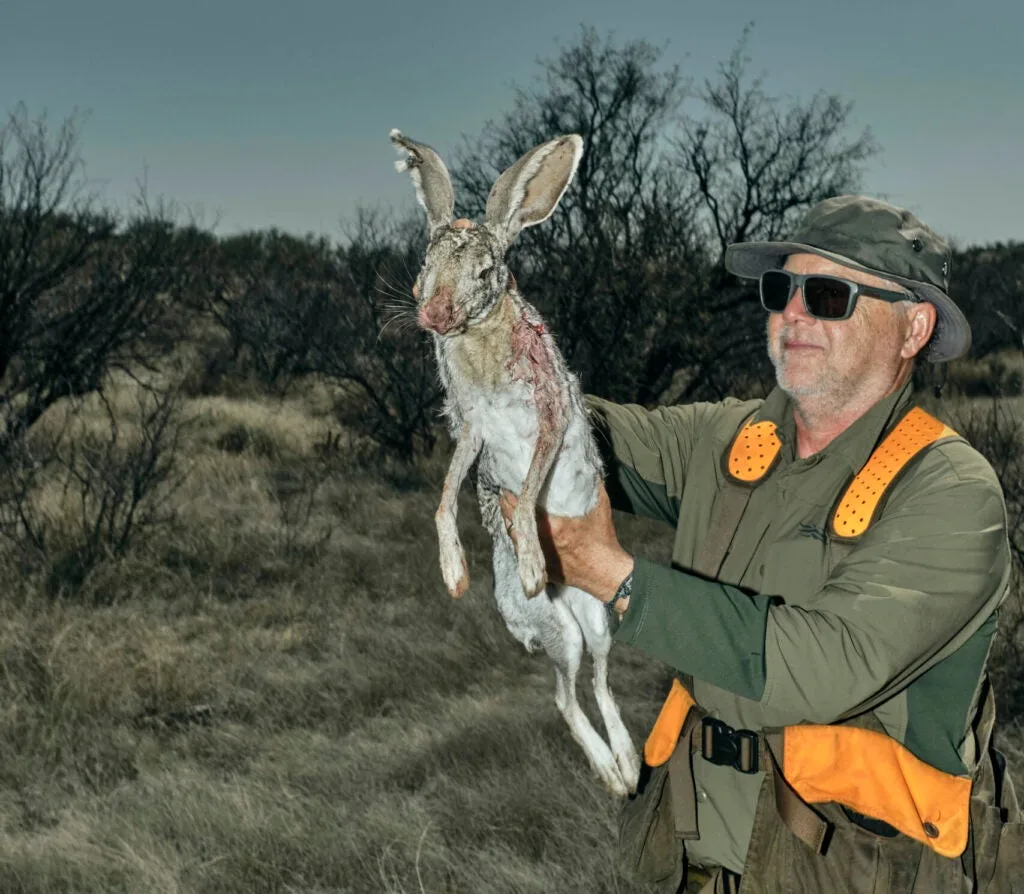
The author shows off a jackrabbit. Ian Allen
“You know Bugs Bunny was a jackrabbit, right?” he asks. I laugh and shake my head, nearly accustomed now to the running trivia show of jackrabbit mania. “Yep, It’s true. In one episode, Shishkabugs, when the king wanted Yosemite Sam to cook him a meal of hasenpfeffer, Bugs Bunny said, ‘A one-eyed jack beats a king every time.’ So Bugs was a jack. A lot of people don’t know that.”
Of that I am certain.
It is early in the morning, and we are walking toward the low sun, watching for the backlit ears of jackrabbits. “They glow like a big neon peach,” O’Dell says. He has segued into an explanation of how Allen’s rule suggests that the appendages of animals in warmer climates tend to be larger in order to exhaust body heat more efficiently when a jackrabbit suddenly vaults at 20 yards. It covers another 40 by the time I get the rifle to my shoulder, then pulls up short, ears glowing, sure enough, like a pair of peaches skewered atop the animal’s skull. By now I’ve worked through my earlier habit of flinching at each Harris’s antelope squirrel or cactus wren that leaps ahead, so I calmly take a backward step to an open-sight picture—
Yowks!
I’ve backed into a cholla cactus. Three of the dill pickle–size pieces embed themselves in my calf, so I keep one eye on the rabbit, twitching nervously at 60 yards, and reach down to pluck out the cactus. I have little experience with this. I try to slip my fingers safely between the big cholla’s large spines, but I don’t realize that the entire cussed cactus chunk is covered with a hellish sheath of smaller spines, a few dozen of which pincushion my fingers.

A prickly hunting hazard. Ian Allen
Incredibly, the jackrabbit holds. But now I have a gun in one hand and the other porcupined with tiny cactus spines. No worries; I’ve picked out a million greenbriers with my teeth while hunting back home, so I bare my chompers. Not smart. Soon I have spines in my calf, my thumb, my fingers, my palm, my lips, my tongue, and the roof of my mouth. The jack is done with this ruckus and bolts off. I spend the next 20 minutes spitting spines out of my mouth. O’Dell howls unsympathetically.
“Yup,” he says, laughing. “That’s Arizona. Where everything is out to kill you.”
The Most Underrated Wild Game Meat?
At our hunt camp one night, O’Dell slices thin strips of jackrabbit backstrap to simmer in a Japanese sukiyaki. Coyotes howl in three directions as the desert air temperature nose-dives. I build up the fire with chunks of mesquite and nab a hunk of simmering jack when O’Dell isn’t looking.
It is delicious.
Truth is, some of the most hardcore hunters in the world will turn up their noses at the jackrabbit. Part of it is the blanket disapproval of rabbits and hares as potential disease carriers. Yes, the animals can be infected with tularemia bacteria. But that’s uncommon, and you can kill the bacteria easily by cooking the meat. “The rest is bullshit,” O’Dell says. “I’ve seen botflies fall out of a deer’s nose and no one suggests throwing a deer away. But one botfly on a rabbit, and the world’s coming to an end. It seems silly.”
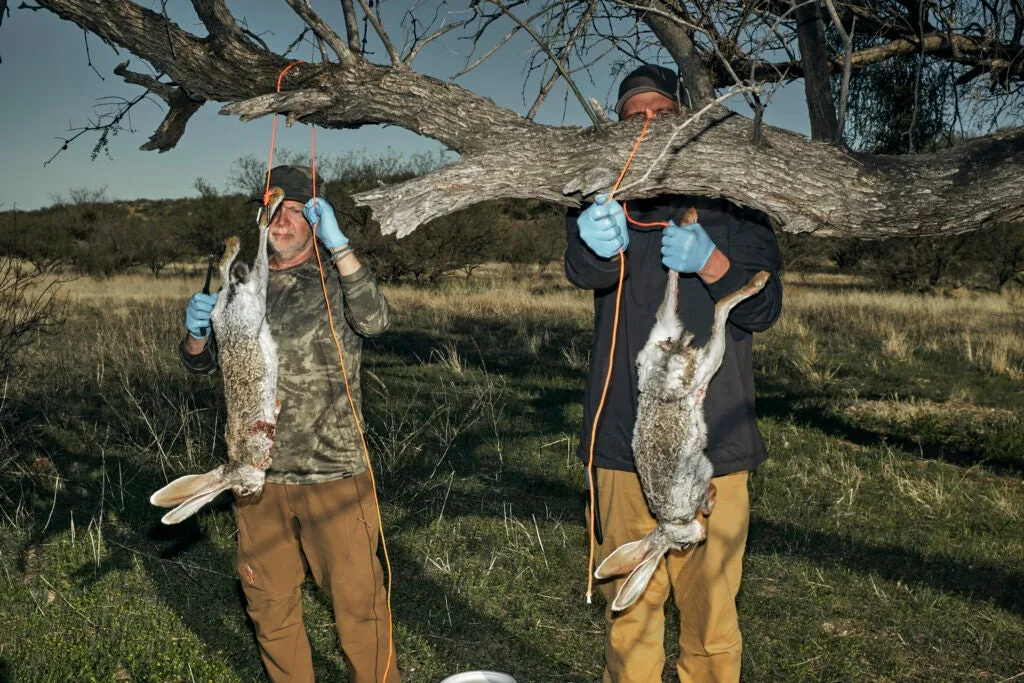
The hunters get to work at the skinning tree before dinner. Ian Allen
And there’s the historic tide that runs against jackrabbit gastronomy. In the Dust Bowl era, massive jackrabbit drives were held to help feed local communities, a tradition that persisted into the 1950s. O’Dell figures that contributes to the poor rap on jackrabbits on the table—they’ve been considered rough food for the down-and-out. “All those ranchers suddenly had to sell their cows and eat rabbits, and they were pissed off about it,” he says. The jack’s reputation has never really recovered.
It’s a situation that weighs heavily on the shoulders of such an outspoken proponent of wild-game cuisine as O’Dell. “These guys are eating cactus fruits, mesquite beans, and fresh grass shoots,” he says. “That’s a high-quality diet, and it’s a lot of meat. This myth about inedible jackrabbits has gone on for too long. It’s pissed me off a little.”
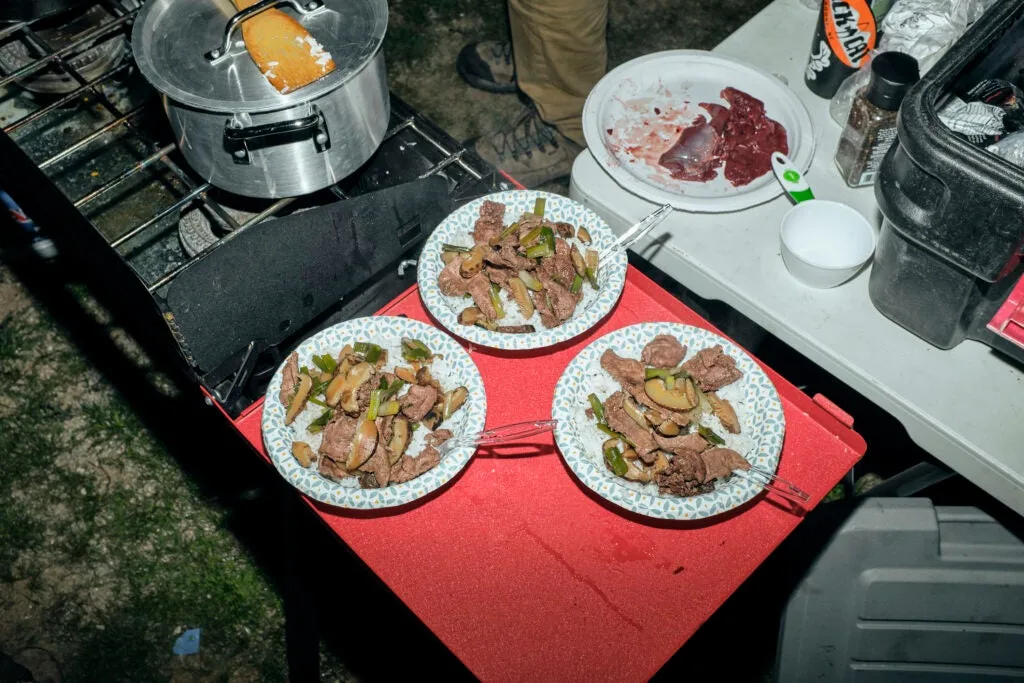
O’Dell cooked up a jackrabbit feast at camp. Ian Allen
O’Dell is grinding his teeth now, so I leave him to his demons. I’m a bit worn out from eight hours of desert hiking, and I still have a few cactus spines to work on.
Hunting in Jack O’Connor Country
The next morning, we wake up to 30 mph gusts thrashing the mesquites. Spot-and-stalk antelope jack hunting is best with just a slight breeze—enough to carry away the sound of footfalls but not so much as to rustle brush and make the rabbits skittish. O’Dell polishes off his second breakfast burrito and glances at the tents flapping in the wind.
“That’s gonna have them riled up,” he says. “Might not be a day for the Jackhammer.” That would be the gun O’Dell carries on most hunts—a Ruger 10/22 capped with a 3X–9X scope for long-range shooting. When he thinks the rabbits might be squirrely, he breaks out the Jackwhacker, another semiauto Ruger 10/22, this one topped with a red-dot scope. It’s a quick-swinging rimfire that makes it easier to keep up with a bunny on the run.
Jackrabbit hunting in this region actually played a critical role in the development of the American rifle-hunting aesthetic, thanks to the animals’ intimate relationship with the dean of American rifle shooting—Jack O’Connor. Born in nearby Nogales, in what was then Arizona Territory, in 1902, O’Connor grew up in a land he called “the last frontier.” He loved hunting Arizona jackrabbits and wrote about long-distance jackrabbit shooting in the journal of the Arizona Game Protective Association and later for Outdoor Life. When food was rationed during World War II, O’Connor fed his family with jackrabbits, and for the rest of his life he credited antelope jack hunting with his famed ability to shoot running game.
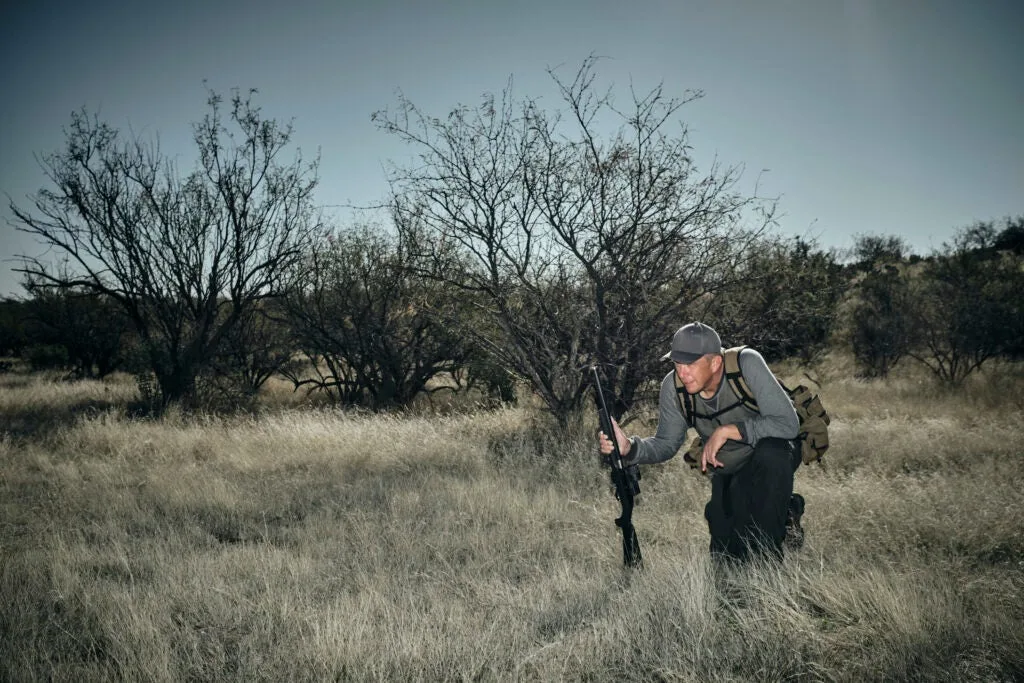
O’Dell gets down on one knee to look for any antelope jacks. Ian Allen
Here, again, O’Dell’s intimate connection to jackrabbits and their role in the American story is uncanny. Like many of their vintage, O’Dell’s father and uncles venerated O’Connor, and he remembers them quoting chapter and verse from the sharpshooter’s articles. As a graduate student at Arizona State University, O’Connor’s own alma mater, O’Dell stumbled across old bound copies of Outdoor Life that carried O’Connor stories. He was enthralled, and the stories and photographs helped kick off his love of small-game hunting. O’Dell actually tracked down some of O’Connor’s favorite jack hunting spots. “Everybody has their heroes,” O’Dell says. “Mine was O’Connor.”
From camp, we drive several miles along a two-track that crosses sandy washes and climbs a rugged slope toward a ridge with 100-mile views in three directions. We look down into a broad, grassy bowl O’Dell calls, simply, the Valley. He’s had some of the best hunts of his life here, and he hopes the topography will blunt the winds.
Another twitch of the foot, and I can sense that every neuron in his body is sizzling like bacon in a skillet. I let out a deep breath and time the pulse in my finger pad as I press the trigger.
We move downslope, keeping 50 to 60 yards between us, like hunters in an old-school deer drive back home. Deep in the foothills, far from the main ranch roads and blacktop, dense grass creates a savanna-like habitat punctuated with mesquite. I chew on a bright-yellow arrow cactus fruit and spit out the tart, slimy pulp. The open glades of grasses make for easier walking, and in places, the scrub is littered with rusty cans, old rope, half-rotted shoes, and black bleach bottles, the preferred water vessel of migrants coming over the nearby Mexican border. Jackrabbits aren’t the only ones seeking shelter here.
Later in the afternoon, the wind finally does settle down, and then, in the last 90 minutes of light, the desert comes alive with rabbits. After being pinned down all day by the wind, the animals seem to emerge, ravenous, from subterranean chambers in the desert. At one point O’Dell and I separate to plumb the sides of a steep escarpment, and I’m wending my way through a mesquite-choked wash, trying to stay off the loud, gravelly sand of the old creek bed, when a jackrabbit breaks from a prickly pear nearly at my feet. It rockets for 75 yards, then inexplicably freezes in an open patch of sand. I bring the gun to my shoulder as if I’m swinging on a rising quail, then settle the crosshairs and squeeze the trigger before I can consciously settle my breath and pick the shot between heartbeats. The jack tumbles on its back and kicks once. At the rifle’s crack, two more bunnies jump out of some god-awful tangle of spines, thorns, and stickers and take off at a dead run. I’m starting to swing when I hear a shot go off to my left and the whine of a ricochet. O’Dell’s on the job too.
“What you got?” he calls.
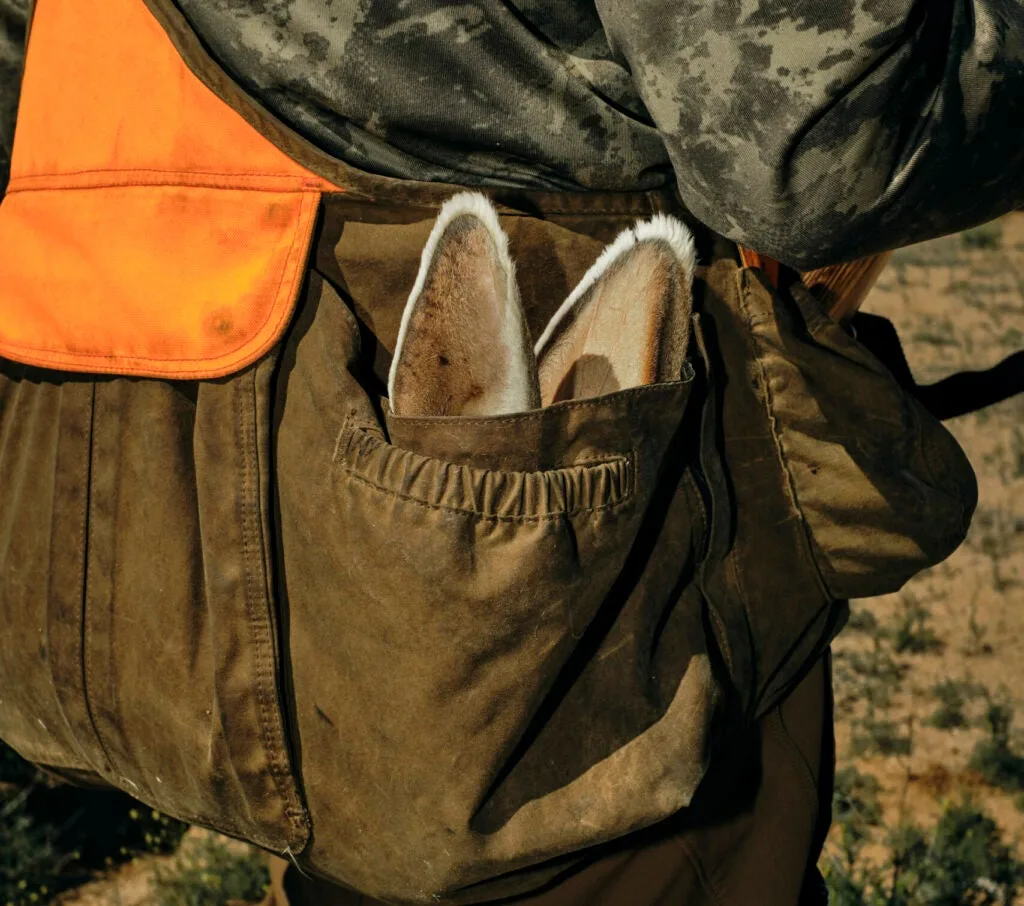
Another jack in the game bag. Ian Allen
I answer that there’s a dead bunny on the ground but a world of fur on the run. He replies with another shot, and I hear the thud of a bullet finding its mark. When I take another few steps, rabbit number four pronks through the brush. I empty the rest of the 10-round clip, and the jackrabbit flips in the mesquite. As if on cue, another pair decide to hit the road with all this fuss, but I’m out of ammo and O’Dell is having too much fun watching me to give them a hollow-point send-off. “Welcome to the Jack O’Connor Running Game Training Facility,” he says.
I watch the last jackrabbits streak toward the horizon, pint-size Tasmanian devils kicking up dust. “This could definitely be a tourist attraction,” I say. “But man, those things are tough. What about the Valley of the Dumb Bunnies? Is that near here? Can we hunt that next?”
A Wild West Showdown
I finally do get the jackrabbit O’Dell promised earlier, the easy one skulking in the shade of a mesquite, sitting all still and quiet and nice and rabbity.
The next day the wind stays down, and we scour sparsely vegetated mesquite flats—definite Jackhammer country. It’s such open terrain that I have to will myself to slow down, to pick my steps, to remember that my quarry has a sonar array on top of its head and eyeballs the size of shooter marbles. I grin when I realize that I’ve settled into my best Eastern Big Woods squirrel-stalking mode: Keep the rifle in the crook of the arm. Always stop in a strip of deep shade. Plant each foot carefully, ready for a quick shot. I move out of a sandy gravel wash to the fringe of grass along the edge, my head on a swivel. And he sees me at the exact moment I see him.
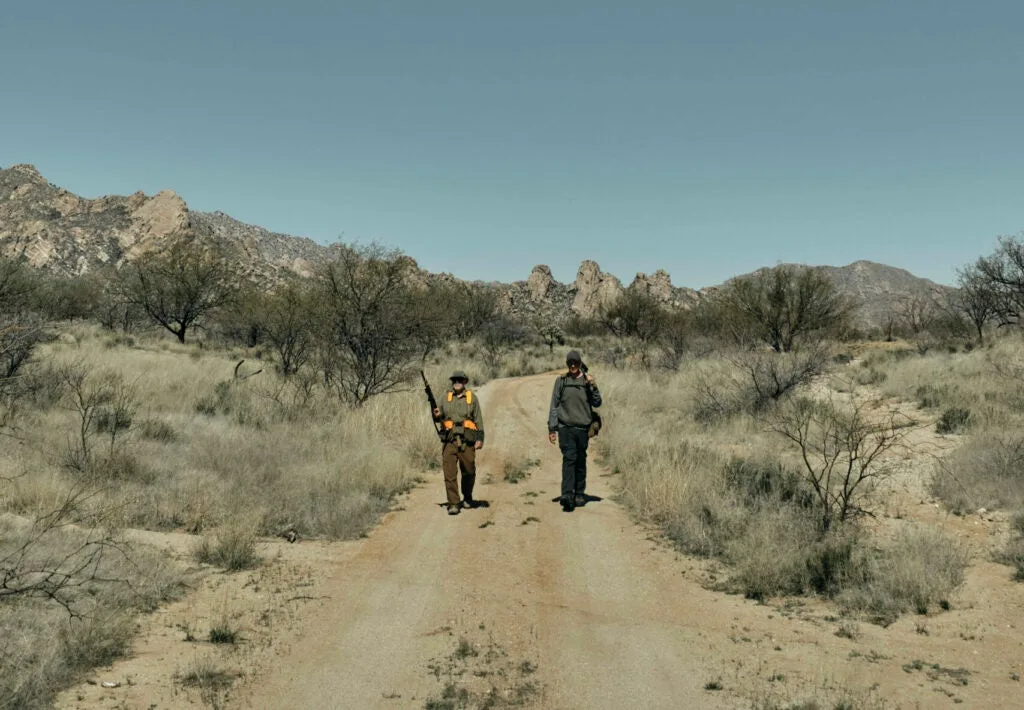
The hunters head back to the truck. Ian Allen
He’s nearly hidden in a confusion of prickly pear pads, his butt tight against the tree bark. As we stare at each other, the jackrabbit subtly shifts his left foot, cocking his leg for blastoff, and in that instant I recall yet another fireside O’Dell jackrabbit trivia fact: The animal’s lower legs and hind feet are put together in a funky offset configuration that keeps the tendons under tension, like a bowstring, so it can erupt from a sitting position to warp speed in, literally, the blink of an eye. I figure the game is up, but the jack settles down. We glare at each other through the heat shimmer. It’s a classic Western showdown, minus the ponchos and spurs.
The jackrabbit twitches his nose; I ease the rifle in front of my body, where it won’t be silhouetted against the light desert behind me. He swivels one ear my way; I snug the rifle stock to my shoulder. Another twitch of the foot, and I can sense that every neuron in his body is sizzling like bacon in a skillet. I let out a deep breath and time the pulse in my finger pad as I press the trigger.
And when the antelope jackrabbit tumbles backward, I can’t help but smile. In this regard, at least, O’Dell and I have much in common: Thirteen hundred miles east of this mesquite wash, and many years ago, I sat in my bedroom with a BB gun, practicing my trigger squeeze, shooting imaginary jackrabbits. I grew up reading Jack O’Connor too.
_This story originally ran in the Great Escapes
issue of_ Field & Stream_. Read more F&S+
stories._


